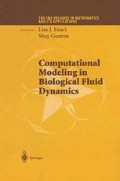Abstract
The coupled system of a viscous, incompressible fluid and a single, force-generating organism is difficult to analyze, even when the kinetics of an organism’s waveform is taken as given. In the past decades, the efforts to describe quantitatively the fluid dynamics of spermatozoa and ciliary propulsion have been very successful. Since the Reynolds number is quite small and inertial effects can be neglected, the linear Stokes flow assumption has been used to investigate the hydrodynamic consequences of flagellar undulations [3]. These investigations have been both analytical and computational. Resistive-force theory, initially developed by Gray and Hancock [12], makes use of the linear Stokes flow assumption, and constructs the flow field by means of distributions of fundamental singularities. Lighthill later improved this theory by incorporating slender body approximations [19], since the diameter of a flagellum is much smaller than its length. More detailed hydrodynamic analysis, such as refined slender body theory and boundary element methods, have produced excellent simulations of both two- and three-dimensional flagellar propulsion in an infinite fluid domain or in a domain with a fixed wall [17], [18], [16], [22]. In addition, ciliary motion, where the effect of a single plane surface at the base of the cilia is included, is studied by Gueron and Liron [14], [15], wherein they also present a thorough survey of flagellar hydrodynamics.
The work of the first author was supported in part by NSF grant DMS-9805501.
The work of the second author was supported in part by NSF grant DMS 9805492 and the NSF Group Infrastructure Grant DMS 9709754.
Access this chapter
Tax calculation will be finalised at checkout
Purchases are for personal use only
Preview
Unable to display preview. Download preview PDF.
References
K.M. Arthurs, L.C. Moore, C.S. Peskin, E.B. Pitman, and H.E. Layton. Modeling arteriolar flow and mass transport using the immersed boundary method. J. Comp. Phys., 147:402–440, 1998.
D.C. Bottino. Modeling viscoelastic networks and cell deformation in the context of the immersed boundary method. J. Comp. Phys, 147:86–113, 1998.
C. Brennen and H. Winet. Fluid mechanics of propulsion by cilia and flagella. Ann. Rev. Fluid Mech., 9:339–398, 1977.
A.J. Chorin. Numerical solution of the Navier-Stokes equations. Math. Comput., 22:745–762, 1968.
R. Dillon and L.J. Fauci. An integrative model of internal axoneme mechanics and external fluid dynamics in ciliary beating, in preparation, 2000.
R. Dillon, L.J. Fauci, A. Fogelson, and D.P. Gaver. Modeling biofilm processes using the immersed boundary method. J. Comp. Phys, 129:57–73, 1996.
R.H. Dillon and L.J. Fauci. Coupling the internal axoneme mechanics of cilia and flagella with external fluid dynamics. In Proceedings of the International Congress on Cilia, Mucus, and Mucociliary Interactions, New York, 1997. Marcel Dekker.
Cd. Eggleton and A.S. Popel. Large deformation of red blood cell ghosts in a simple shear flow. Phys. Fluids, 10:1834–1845, 1998.
L.J. Fauci and A.L. Fogelson. Truncated Newton methods and the modeling of complex immersed elastic structures. Comm. on Pure and Appl. Math., 46:787–818, 1993.
L.J. Fauci and A. Mcdonald. Sperm motility in the presence of boundaries. Bull. Math. Biol., 57(5):679–699, 1995.
A.L. Fogelson. Continuum models of platelet aggregation: Formulation and mechanical properties. SIAM J. Appl. Math, 52:1089–1110, 1992.
J. Gray and G. Hancock. The propulsion of sea-urchin spermatozoa. J. Exp. Biol, 32:802–814, 1955.
S. Gueron, K. Levi-Gurevich, N. Liron, and J.J. Blum. Cilia internal mechanism and metachronal coordination as the result of hydrodynamic coupling. Proc. Natl. Acad. Sci. USA, 94:6001–6006, 1997.
S. Gueron and N. Liron. Ciliary motion modeling, and dynamic multicilia interactions. Biophys. J., 63:1045–1058, 1992.
S. Gueron and N. Liron. Simulations of three-dimensional ciliary beats and cilia interactions. Biophys. J., 65:499–507, 1993.
J.J.L. Higdon. The generation of feeding currents by flagellar motion. J. Fluid Mech., 94:305–330, 1979.
J.J.L. Higdon. A hydrodynamic analysis of flagellar propulsion. J. Fluid Mech., 90:685–711, 1979.
J.J.L. Higdon. The hydrodynamics analysis of flagellar propulsion: helical waves. J. Fluid Mech., 94:331–351, 1979.
J.L. Lighthill. Flagellar hydrodynamics. SIAM Review, 18:161–230, 1976.
M. Murase. The Dynamics of Cellular Motility. John Wiley, Chichester, 1992.
C.S. Peskin. Numerical analysis of blood flow in the heart. J. Comp. Phys., 25:220–252, 1977.
N. Phan-Thien, T. Tran-Cong, and M. Ramia. A boundary-element analysis of flagellar propulsion. J. Fluid Mech., 184:533–549, 1987.
G.B. Witman. Introduction to cilia and flagella. In R.A. Bloodgood, editor, Ciliary and Flagellar Membranes, pp. 1–30, New York, 1990. Plenum.
Author information
Authors and Affiliations
Editor information
Editors and Affiliations
Rights and permissions
Copyright information
© 2001 Springer Science+Business Media New York
About this paper
Cite this paper
Dillon, R.H., Fauci, L.J. (2001). A Fluid-Structure Interaction Model of Ciliary Beating. In: Fauci, L.J., Gueron, S. (eds) Computational Modeling in Biological Fluid Dynamics. The IMA Volumes in Mathematics and its Applications, vol 124. Springer, New York, NY. https://doi.org/10.1007/978-1-4613-0151-6_4
Download citation
DOI: https://doi.org/10.1007/978-1-4613-0151-6_4
Publisher Name: Springer, New York, NY
Print ISBN: 978-1-4612-6539-9
Online ISBN: 978-1-4613-0151-6
eBook Packages: Springer Book Archive

